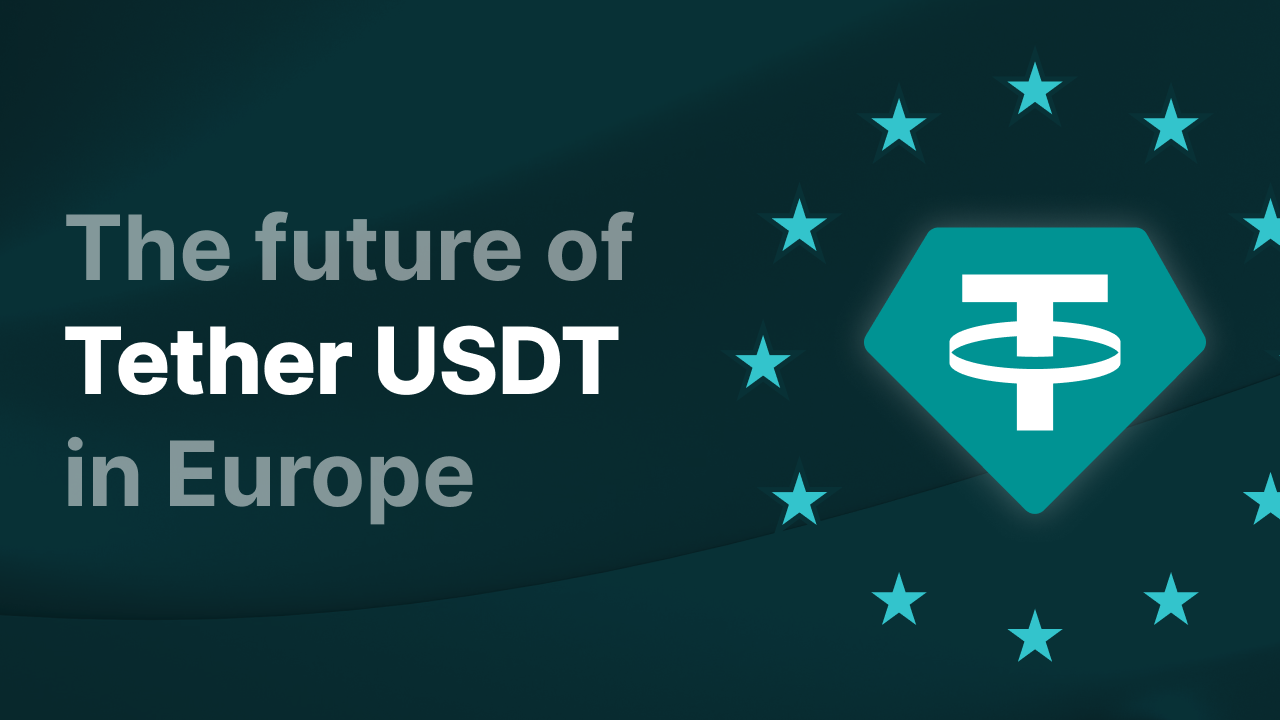The Future of Tether (USDT) in Europe

The article looks at the future of Tether (USDT) and stablecoins in Europe under the incoming Markets in Crypto-Assets (MiCA) regulation.
Key takeaways
- Tether (USDT) is a stablecoin, a digital currency that is pegged to the value of the US dollar.
- A stablecoin is a type of cryptocurrency designed to maintain a stable value by being pegged to a reserve of assets.
- The Markets in Crypto-Assets (MiCA) regulation is a comprehensive legal framework proposed by the European Union (EU) to regulate the cryptocurrency market and its participants.
- The MiCA regulations will mandate stablecoin issuers to be governed as electronic money institutions. Consequently, many stablecoins available in Europe are currently unregulated since they lack authorization and regulation as e-money transmitters.
What is Tether (USDT)?
Tether (USDT) is a stablecoin, a digital currency that is pegged to the value of the US dollar. It is issued by a centralized company called Tether and is used to minimize volatility in an investor's portfolio. It is also widely accepted as a payment method and is supported on multiple blockchains. USDT is often used in conjunction with cryptocurrency debit cards and is popular in the decentralized finance (DeFi) space for lending and borrowing. It is the third-largest cryptocurrency by market capitalization and is backed by reserves in cash and cash equivalents, allowing token holders to redeem their USDT for USD. Tether has also issued other stablecoins pegged to the value of other fiat currencies and commodities, such as the Chinese Yuan, the Euro, and gold.
What is a stablecoin?
A stablecoin is a type of cryptocurrency designed to maintain a stable value by being pegged to a reserve of assets. This stability aims to reduce the volatility that is common with other cryptocurrencies like Bitcoin or Ethereum. Here are the key characteristics and types of stablecoins:
Key Characteristics of Stablecoins
Stability: The primary goal of a stablecoin is to provide price stability, making it more reliable for transactions and as a store of value compared to other cryptocurrencies.
Pegged to another asset: Stablecoins are typically pegged to a reserve asset, which can be fiat currency (like the U.S. dollar), other cryptocurrencies, or even commodities (like gold).
Backing: To maintain the peg, stablecoins are backed by reserves. These reserves can be held in various forms such as bank deposits, short-term debt, or other financial instruments.
Transparency and Audits: Issuers of stablecoins often provide regular audits and transparency reports to prove that their reserves are sufficient to back the stablecoins in circulation.
Types of Stablecoins
Fiat-Collateralized Stablecoins: These are backed by a reserve of fiat currency. For example, each Tether (USDT) is supposed to be backed by one U.S. dollar held in reserve. Other examples include USD Coin (USDC) and TrueUSD (TUSD).
Crypto-Collateralized Stablecoins: These are backed by other cryptocurrencies. To account for the volatility of the backing cryptocurrency, these stablecoins are often over-collateralized. For example, Dai (DAI) is backed by Ethereum and other cryptocurrencies through the MakerDAO system.
Commodity-Collateralized Stablecoins: These are backed by commodities like gold or other precious metals. An example is PAX Gold (PAXG), where each token represents a specific amount of physical gold.
Algorithmic Stablecoins: These do not rely on collateral but instead use algorithms and smart contracts to control the supply of the stablecoin, thereby maintaining its peg. The algorithm increases or decreases the supply based on the stablecoin’s market price. An example is TerraUSD (UST), though it has faced issues with maintaining its peg.
Uses of Stablecoins
Trading and Hedging: Traders use stablecoins to hedge against market volatility without converting to fiat.
Payments and Remittances: Stablecoins facilitate faster and cheaper cross-border transactions compared to traditional banking systems.
Decentralized Finance (DeFi): Stablecoins are integral to the DeFi ecosystem, providing liquidity and acting as collateral for various financial services.
Stablecoins aim to combine the benefits of cryptocurrencies (such as fast, borderless transactions) with the stability of traditional financial assets, making them a vital component of the digital economy.
So now that we’ve looked at Tether (USDT) and the overall realm of stablecoins, let’s look at how the Markets in Crypto-Assets (MiCA) regulation will affect this group.
What is the Markets in Crypto-Assets (MiCA) regulation?
The Markets in Crypto-Assets (MiCA) regulation is a comprehensive legal framework proposed by the European Union (EU) to regulate the cryptocurrency market and its participants. The regulation aims to create a unified regulatory environment across the EU for crypto-assets, enhancing investor protection, market integrity, and financial stability. Here are the key aspects of MiCA:
Objectives of MiCA
Consumer and Investor Protection: MiCA aims to ensure that consumers and investors are adequately informed about the risks associated with crypto-assets and are protected from fraud and market manipulation.
Market Integrity and Financial Stability: The regulation seeks to prevent market abuse and ensure the orderly functioning of crypto markets. It also aims to mitigate the potential systemic risks posed by certain types of crypto-assets.
Legal Clarity and Certainty: MiCA provides clear definitions and classifications for different types of crypto-assets, reducing regulatory uncertainty and fostering innovation in the crypto industry.
Scope and Applicability
MiCA applies to a wide range of crypto-assets, including:
- Utility Tokens: Tokens that provide access to a product or service.
- Asset-Referenced Tokens: Tokens pegged to a basket of assets like fiat currencies, commodities, or other cryptocurrencies.
- Electronic Money Tokens (e-money tokens): Tokens that are pegged to a single fiat currency, similar to stablecoins like USDT or USDC.
- Other Crypto-Assets: Any other crypto-assets not falling under the aforementioned categories.
Key Provisions
Authorization and Supervision: Crypto-asset service providers (CASPs) must obtain authorization from national competent authorities to operate within the EU. This includes exchanges, wallet providers, and other related services.
Whitepaper Requirements: Issuers of crypto-assets must publish a detailed whitepaper containing essential information about the project, the issuance, and the rights and obligations of the token holders.
Capital Requirements: MiCA imposes specific capital requirements on issuers of certain types of crypto-assets, especially those considered to pose higher risks, such as asset-referenced tokens and e-money tokens.
Governance and Risk Management: Issuers and service providers must implement robust governance frameworks and risk management procedures to ensure compliance and operational resilience.
Consumer Protection Measures: The regulation includes provisions to protect consumers, such as ensuring that they have access to information about the risks involved in crypto-asset investments and that they have recourse in case of disputes.
Stablecoin Regulation: MiCA introduces specific rules for stablecoins, requiring issuers to maintain sufficient reserves and provide regular reports to regulators.
Implementation Timeline
MiCA was officially approved by the European Parliament in April 2023, and it is expected to come into effect gradually over the next few years. Companies operating in the EU will need to comply with MiCA's requirements to continue their operations.
Impact on the Crypto Industry
MiCA is expected to have a significant impact on the crypto industry by:
- Promoting Innovation: By providing legal clarity and reducing regulatory uncertainty, MiCA may encourage more businesses to innovate and develop new products and services in the crypto space.
- Enhancing Market Confidence: Increased regulation and oversight can boost investor confidence in the crypto market, potentially attracting more institutional investors.
- Standardizing Regulations: MiCA aims to harmonize regulations across the EU, reducing the complexity of complying with different national laws and fostering a more integrated market.
Overall, MiCA represents a major step toward the mainstream adoption and regulation of crypto-assets in the European Union.
The impact of MiCA on Tether (USDT) and stablecoins
The MiCA regulations will mandate stablecoin issuers to be governed as electronic money institutions. Consequently, many stablecoins available in Europe are currently unregulated since they lack authorization and regulation as e-money transmitters. Circle, the company behind the second-largest stablecoin USDC, and the euro-pegged token EURC, has obtained conditional registration for digital asset services in France and has applied for an electronic money institution license in the E.U.
It’s safe to say that the coming months will be telling for USDT’s future in Europe. Rest assured, we’ll keep you posted and communicate with you accordingly if this has any impact on your crypto activity.
